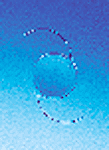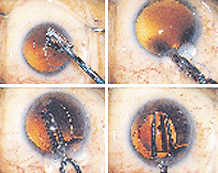Working with surgeons, patients to improve the success rate of IOLs
When a patient needs to undergo cataract surgery, choosing the correct IOL to implant depends on that particular person’s needs and lifestyle. Patient education, a thorough discussion between the doctor and patient and the practitioner’s own judgment all play a key role in determining which lens to use as well as the surgical technique performed.
Jeffrey Augustine, OD, director of refractive surgery at the Center for Sight in Cleveland, who comanages cataract patients with Robert Wiley, MD, said that a high success rate accompanies choosing appropriate candidates for the silicone Array Multifocal IOL (Allergan, Irvine, Calif.). “We make sure the pupils are big enough,” he told Primary Care Optometry News. “We don’t choose patients with small pupils. Larger pupils seem to work well.”
In addition, he said, patient expectation is a large factor to be taken into consideration. If patients want desperately to shed their glasses he will explore the multifocal lens route. But if patients are expecting crystal-clear vision, they most likely will be very disappointed. He advises educating patients ahead of time about the probability of slightly blurred vision, particularly if patients have a job that requires a lot of nighttime driving. “I say that things aren’t going to be exactly, perfectly clear at a distance and they won’t be perfectly clear up close, but you’ll be able to function,” he said.
Benefits of the Array Multifocal
 ---Array Multifocal: This lens may be suitable for patients intent on shedding their glasses.
---Array Multifocal: This lens may be suitable for patients intent on shedding their glasses.
One of the main advantages, of course, is the potential freedom from wearing spectacles — if the patient will be content with not-so-perfect vision, of course. Randy Andregg, OD, in private group practice in Boise, Idaho, said that the Array lens provides the patient with more flexibility. “Individuals are less dependent upon a reading correction; there are some things that they can manage with the IOLs themselves,” he said. “Those individuals who are on a computer, for example, seem to do fairly well, as the distance of the monitor is a little farther than the normal reading distance. I think they do quite well at those intermediate distances.”
Dr. Augustine said that, as long as patients are properly informed from the beginning, the success rate will be high, such as has been his experience. “We screen to determine which patients would be good candidates, and there’s about a 90% satisfaction rate for those we choose,” he said.
Visual aberrations with the Array
While some practitioners have reported their patients having trouble with halos or ghosting effects, Dr. Andregg said he has witnessed relatively few patients who relate such problems. “It’s a pretty small percentage, probably 10% or less,” he said. “With night driving, there seems to be a complaint of halos, something similar to that of a refractive surgery patient.”
To cut down on visual disturbances while driving at night, Dr. Andregg said he will suggest ways of making the patient’s pupil constrict more, which has met with mixed results. “I’ve treated those patients like I would a refractive surgery patient who’s complaining about a limited optical zone size on the cornea,” he said. “We’ve had limited success with things like turning on the dome light of the car to constrict the pupil. Sometimes that’s satisfactory, sometimes not.”
Dr. Augustine said that while patients complaining about such aberrations are the exception rather than the rule, the problem has occurred. He noted that one patient in particular, a truck driver who needed crisp distance vision, needed to have one Array lens removed and replaced with a different lens because of ghosting and halos. For those who retain their lenses, Dr. Augustine suggested prescribing a low prescription spectacle for use at night. “I’ve prescribed some antireflective-coated lenses in a light yellow tint, from +0.50 to +1.00 D. That helps,” he said. “Some patients, also, still require reading glasses for very small print.”
The switch to acrylic: AcrySof
 ---Implanting the AcrySof foldable lens: Lens folded before insertion (top left); lens introduced through clear corneal incision (top right); lens released for unfolding within the eye (bottom left); lens slowly unfolds (bottom right).
---Implanting the AcrySof foldable lens: Lens folded before insertion (top left); lens introduced through clear corneal incision (top right); lens released for unfolding within the eye (bottom left); lens slowly unfolds (bottom right).
The monofocal AcrySof (Alcon, Ft. Worth, Texas) lens, one of the first non-silicone acrylic lenses used in the United States, is a foldable IOL that has garnered some criticism for having a sharp edge that causes the wearer to experience a glare or other unwanted optical images.
Howard Friedberg, MD, who is in private practice in Woodbury, N.J. and specializes in cataract and refractive surgery, says he rarely encounters a patient who experiences this problem. Even then, the visual disturbance — more of a reflection than a glare — usually stems from an overhead light, he said. “The other problem that I sometimes notice is that people looking at them will notice a glimmer in the patient’s eye, which is also just a reflection,” he said.
Dr. Friedberg said that while the reflection may be distracting and slightly bothersome at first, he has not had a patient who could not adjust to the problem or who did not experience a cessation of the symptoms altogether. “Usually, given time, the problem does go away as the peripheral anterior capsular flap and posterior capsule opacifies,” he noted. “I’ve been using the lens for at least 4 years and I’ve never had to remove one for this problem.”
The reports of reduced occurrence of posterior opacification are making Dr. Wiley consider switching to the AcrySof lens. “I’m not considering switching because it folds easily, because I can put it through a smaller incision or because I’m going to do a clear cornea incision,” he said. “I might switch because there’s a lower incidence of opacification of the posterior capsule.”
Reduced need for capsulotomy
One of the biggest benefits of AcrySof, Dr. Friedberg said, is that the posterior capsule stays clearer than with either the three-piece or plate-haptic silicone lenses. “Also, my capsulotomy rate, as a result, has dropped significantly using this lens,” he noted. “When I’ve had to do the capsulotomies — the percentages of which are in the single digits — the lens is YAG-friendly, as compared to some of the silicone lenses that pit when a YAG capsulotomy is performed.”
He said that another advantage of the AcrySof is a slow, controlled opening following a relatively simple insertion. “You can use forceps as opposed to having various cartridges and injectors that some of the silicone lenses use,” he said.
Dr. Friedberg added that other advantages of the AcrySof lens include excellent centration and biocompatibility. The lens results in very little post-op inflammation, making it ideal for patients with uveitis or those needing combined glaucoma-filtering surgery, he said.
While he has tried prescribing medication in the past, such as pilocarpine or other miotics, Dr. Friedberg said that such a measure is usually unnecessary. “For the most part, patients feel their problem is really not severe enough to warrant use of medication,” he said.
Clear cornea vs. scleral tunnel
Although Dr. Wiley expects to make the transition to a foldable IOL eventually, he says he is confident in making the larger scleral tunnel incision and would want to continue entering at the limbus. “I don’t have any difficulty in making a larger incision to insert a lens and making it a very astigmatic neutral endpoint with no stitches,” he said. “If I were having trouble with astigmatism with my wounds, or with flat chambers and wounds that weren’t healing, then I’d want them smaller. But the way I make my wound, I feel I have a technique and a procedure that works very well.”
Dr. Wiley said that with his method of limbal incision, which cuts the blood vessels approximately 1 mm posterior to the limbus, the wounds tend to be stronger and faster healing with a reduced incidence of astigmatism. “A lot of doctors want to go to clear corneas so they have nice, white eyes the first day postop,” he said. “I don’t think having a white eye the first day postop is a big advantage. That means you haven’t got an inflammatory response, you haven’t cut blood vessels and the wound is going to take several weeks to be as secure as my wound will be in 24 to 48 hours.”
In his comanagement of cataract patients, Dr. Andregg disagrees, arguing that a clear-corneal incision produces less edema and significantly less swelling than a scleral tunnel incision. “The patient stabilizes sooner, and we’re able to provide a refractive correction, if they need it, for distance or especially for near,” he said.
Dr. Andregg maintains that a corneal incision heals quickly and that astigmatism is not significantly increased. “The really small incisions that are used are 3 to 3.5 mm,” he said. “They’re not like a regular A-K incision, which usually runs a lot wider than that. Typically, if a patient is a high astigmat, the surgeon can rotate the entry point to accommodate that.”
Depending on a particular patient’s level of astigmatism, Dr. Friedberg said that he has used both methods. “I aim for a small amount of myopia, and that’s where they usually end up,” he said.
Doctor recommendation
No matter which lens or incision the doctor decides to use, a successful outcome depends largely upon what kind of patient is being dealt with, especially when it comes to multifocal lenses, Dr. Augustine said. One factor is the patient’s own knowledge about the subject before even seeing the doctor. “If patients are well educated prior to the procedure, the success rate is much better,” he said.
For Your Information:
- Robert Wiley, MD, and Jeffrey Augustine, OD, FAAO, may be reached at the Center for Sight, Cleveland Eye Clinic, 2740 Carnegie Ave., Cleveland, OH 44115; (216) 621-6132; (800) 875-0300; fax: (216) 621-2803.
- Randy Andregg, OD, may be reached at Vision One, 610 Americana Blvd., Boise, ID 83702; (208) 344-2020.
- Howard Friedberg, MD, may be reached at 661 North Broad St., Woodbury, NJ 08096; (609) 845-7968; fax: (609) 845-8544. Drs. Wiley, Augustine, Andregg and Friedberg have no direct financial interest in the products mentioned in this article, nor are they paid consultants for any companies mentioned.
- For more information on the AcrySof IOL, contact Alcon International, 6201 South Freeway, Ft. Worth, TX 76134; (817) 551-6828; fax: (817) 568-7116.
- For more information on the Array Multifocal IOL, contact Allergan at 2525 Dupont Dr., P.O. Box 19534, Irvine, CA 92623-9534; (714) 752-4500; fax: (714) 955-6987.
